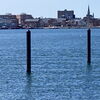
UMaine unveils world’s largest 3D printer
 Photo / Laurie Schreiber
The University of Maine’s new 3D printer is the largest in the world, capable of producing objects up to 100 feet long by 22 feet wide by 10 feet high.
Photo / Laurie Schreiber
The University of Maine’s new 3D printer is the largest in the world, capable of producing objects up to 100 feet long by 22 feet wide by 10 feet high.
More than 200 people on Thursday watched University of Maine staff and students from the school's Advanced Structures & Composites Center unveil its new 3D printer — the largest in the world.
The massive printer can produce objects up to 100 feet long by 22 feet wide by 10 feet high.
“This 3D printer is an outgrowth of research we have been doing for 15 years in combining cellulosic nano and micro fibers with thermoplastic materials,” said Habib Dagher, the center’s founding executive director. “Our goal is to print with 50% wood products at 500 pounds per hour, and achieve properties similar to aluminum.”
For now, the printer is set up on a 70-foot-long bed.
“We didn’t have room, so we put in 70 feet,” Dagher said. “Our goal is to build a bigger lab.”
New forest products market
The printer purchase is part of a $20 million additive manufacturing collaboration, funded by the U.S. Department of Energy’s Advanced Manufacturing Office, between the composites center and the DOE's Oak Ridge National Laboratory. The initiative is designed to expand the potential of the 3D printing market and create a new market for Maine’s forest products.
Oak Ridge and UMaine are working with the industry to produce new bio-based materials that will be conducive to printing a variety of large, structurally demanding products.
The printer is expected to support several private, defense and infrastructure applications.

Fast prints
To demonstrate its capabilities, the center had printed a 25-foot, 5,000-pound patrol boat. It’s the largest 3D-printed object in the world. Christened 3Dirigo, its hull form was developed by Navatek, a global ship design firm with an office in Portland, and a UMaine Composites Center industrial partner. The boat was printed over the course of three days, from Sept. 19 to 22.

“This is the biggest printed boat in the world,” said Dagher. The previous largest was a 40-pound rowboat printed on the West Coast, he said.
To view a time-lapse video of the boat's production, click here.
UMaine also showcased a 3D-printed 12-foot-long U.S. Army communications shelter that’s shaped like a shipping container. The prototype was developed in cooperation with the U.S. Army Combat Capabilities Development Command Soldier Center, in Natick, Mass. Other potential military uses include concealment applications, additional structural shelters and high-temperature fire-retardant materials for vehicle-mounted shelters.
“The innovation that we have witnessed here at the University of Maine will revolutionize how the Army prototypes and manufactures shelters, vehicles and other large systems,” said Col. Frank Moore, military deputy for the soldier center.

Working with the U.S. Army Corps of Engineers, it’s expected the printer will advance UMaine’s innovations in infrastructure systems, including a 5,000-pound, 21-foot-long 3D-printed mold for a new 76-foot-long composites bridge girder that’s planned for use in the construction of a bridge in Hampden.
The composites center is also helping Maine boatbuilders to explore how large-scale 3D printing, using economical, wood-filled plastics, can provide the industry with a competitive advantage. It’s expected that by printing plastics with 50% wood, boat molds and parts can be produced more quickly and economically than today’s methods.
Other print products envisioned include building components, tooling for composites and wind blades.
Guinness world records
The unveiling in Orono was attended by university and government leaders, including representatives of the U.S. Army, U.S. Navy, Department of Education and Oak Ridge, along with Maine boatbuilders and other industrial partners. Boatbuilders on hand included JB Turner, president of Front Street Shipyard in Belfast; Tim Hodgdon, president of Hodgdon Yachts in Boothbay Harbor; and Kevin Burns, vice president of design and product development at Sabre Yachts in Raymond. Other industry representatives present were from Navatek and Cianbro.
A Guinness World Records adjudicator presented the center with certifications for three world records — for the world's largest polymer 3D printer, largest 3D printed boat and largest solid 3D printed item.
U.S. Sen. Susan Collins, R-Maine, noted an additional $20 million for the additive manufacturing program is included in a Senate Appropriations Committee-approved energy funding bill.
Strong, stiff material
Oak Ridge is a leader in advanced manufacturing and is the Department of Energy’s largest science and energy lab. The composites center is a leader in cellulose nano fiber and its use in combination with thermoplastic composites.
Cellulose nano fiber is cellulose that has been broken down to a scale of nanometers, or billionths of a meter. Placing cellulose nano fiber into plastics results in strong, stiff and recyclable bio-derived material that becomes filament in the 3D printer.
The research will focus on cellulose nanofiber production, drying, functionalization and compounding with thermoplastics. By placing cellulose nanofiber from wood into thermoplastics, bioderived recyclable material systems can be developed with properties that may rival traditional materials, possibly even metals.
Nano cellulose is stronger than steel and stiffer than Kevlar, said Moe Khaleel, associate laboratory director for Energy and Environmental Sciences at Oak Ridge, The “green” material formulation results in 50% cost reduction and 90% reduction in carbon footprint.
“This is the new era of the bio-economy,” Khaleel said.
The printer’s value for UMaine includes new opportunities to cultivate interdisciplinary research as well as next-generation innovators, said Joan Ferrini-Mundy, the university’s president.















0 Comments